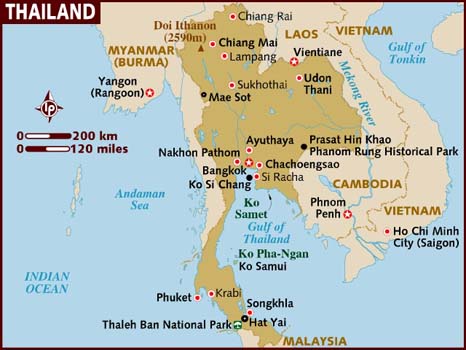Astonishingly exotic and utterly compelling, Thailand is a country of breathtaking natural beauty with an incredible heritage that quickly becomes addictive.
Remember how your parents used to tell you to keep your elbows off the table during meals? Or that it’s rude to slurp your soup? Well there’s good news guys, these American cultures and customs don’t always translate to other countries! While the local people you meet won’t expect you to be fluent in their language, culture and customs, it is important to familiarize yourself with them.
Do you know how kissing, snoring and other things sound in other languages? That’s right, even sound effects can be translated!
The most important thing to remember while you’re abroad is that things will be different. But, different doesn’t mean wrong. Be open, be curious, and read more about the culture you will be stepping into. Get excited about LIVING the life you’ve only dreamt and read about until now!
#CISabroadtip: Do some more research into the Thai customs you’ll experience while abroad.
#CISAlumniTip
“Studying abroad in Thailand changed my entire perspective on how I want to live my life professionally and personally. It also inspired a new passion for traveling and seeing parts of the world that are less traditional destinations. Most of all, studying abroad has shown me how amazing of an experience studying in another country is and has given me a desire to help other students have the experience of studying abroad as well.” – Cody T., Semester in Thailand Alumnus.
Here’s a video explaining how to “wai” when you greet others:
We recommend these additional reading on people and demographics as well.
People and Culture in Thailand
Official name: Kingdom of Thailand
Population: 66.7 million
Capital City: Bangkok
Religions: Buddhism 95%, Muslim 3.8%, Christianity 0.5%, Hinduism 0.1%, other 0.6%
Location: Southeastern Asia, bordering the Andaman Sea and the Gulf of Thailand, southeast of Burma

Culture in Thailand:
- The wai (as mentioned above) is the traditional form of greeting, given by the person of lower status to the person of higher status.
- Step over the threshold rather than on it. This is an old custom that may be dying out with younger Thais, but erring on the side of conservatism is always a good idea.
Table Manners:
- A fork and spoon are the usual eating utensils. However, noodles are often eaten with chopsticks.
- The spoon is held in the right hand and the fork in the left. The fork is used to guide food on to the spoon. Sticky rice, a northern Thai delicacy, is often eaten with the fingers of the right hand.
- Most meals are served as buffets or with serving platters in the centre of the table family- style.
- You may begin eating as soon as you are served.
- Never leave rice on your plate as it is considered wasteful. The words for food and rice are the same. Rice has an almost mystical significance in addition to its humdrum ‘daily bread’ function.
Phrases to know before you go:
| Sawatdee (krub/kah) | Hello |
| Sabai dee ru (krub/kah) | How are you? |
| Sabai dee (krub/kah) | Fine |
| Khob Khun (kup/kaa) | Thank you |
| chai | Yes |
| mai chai |
No |
| dai | (you/ I) can |
| mai dai | can not |
| mai pen rai |
never mind (handy all purpose phrase to express the Thai go-with-the-flow attitude) |
| pood Thai mai dai | I can not speak Thai. |
| kow jai mai | do you understand? |
| mai kow jai | I do not understand |
| nee Tao Rai? | How much? |
| pang | expensive |
| pang mak | very expensive |
| lot noi dai mai | can you give a little discount |
| took | cheap |
| naam | water |
| chok dee | good luck |
| sanaam bin | Airport |
| ron | hot |
| nao | cold |
| hong naam | toilet |
| naam keng | ice |
| nit noi | small – not much – a little bit |
| yai | large |
| bia | beer |
| soopburi | smoke (inhale cigarette smoke) |
| neung | 1 |
| song |
2 |
| sam |
3 |
| see |
4 |
| haa | 5 |
| hok | 6 |
| jet |
7 |
| paed |
8 |
| gow |
9 |
| sip |
10 |
| sip-et |
11 |
| sip-song |
12 |
| yee sip |
20 |
| saam sip |
30 |
| roi/loi |
100 |
